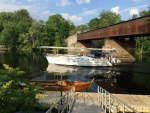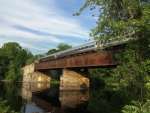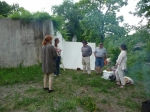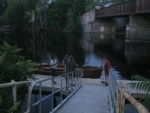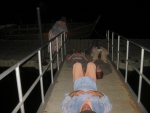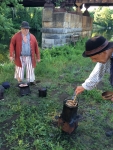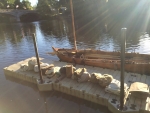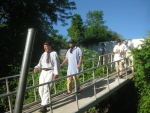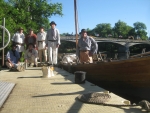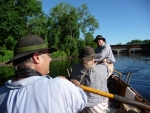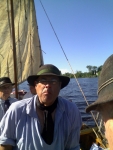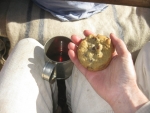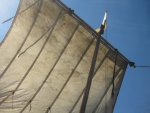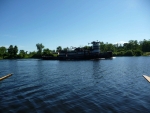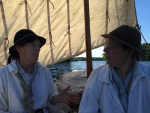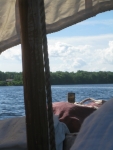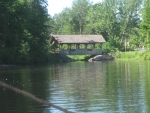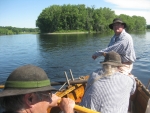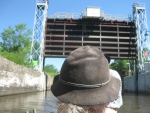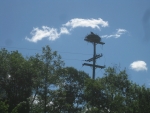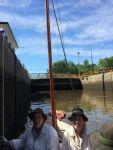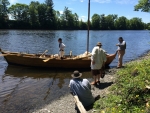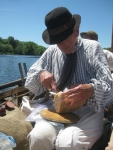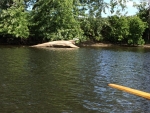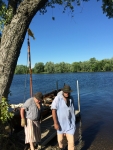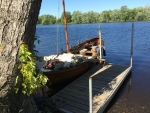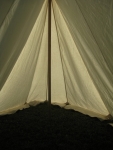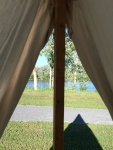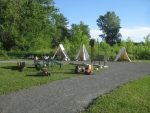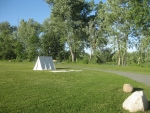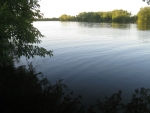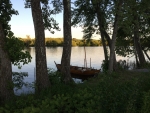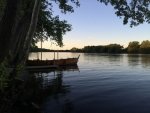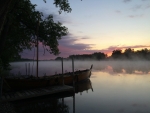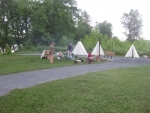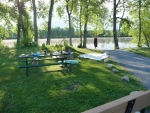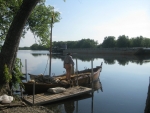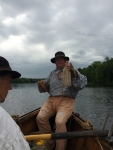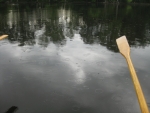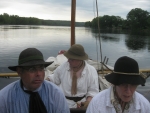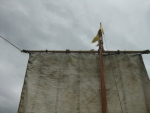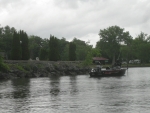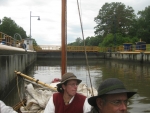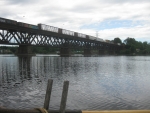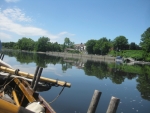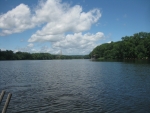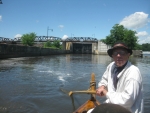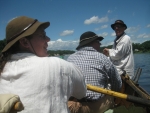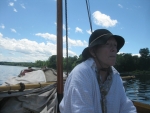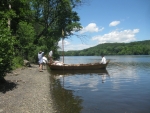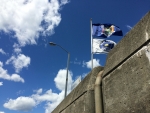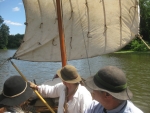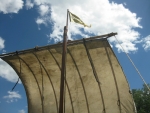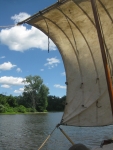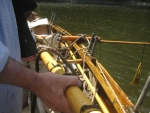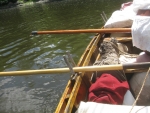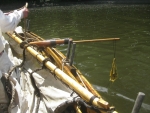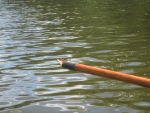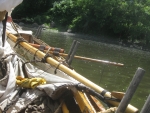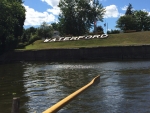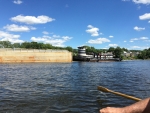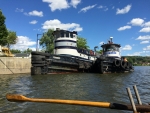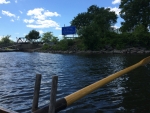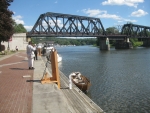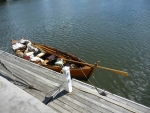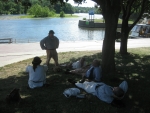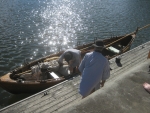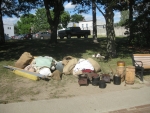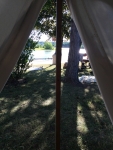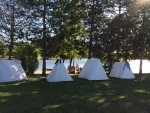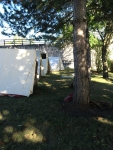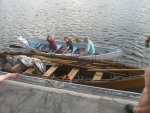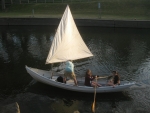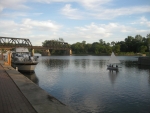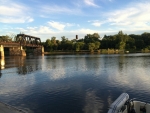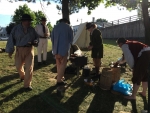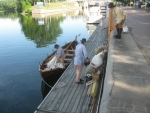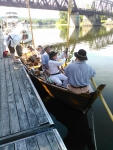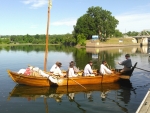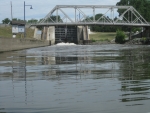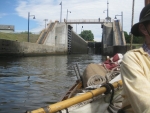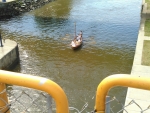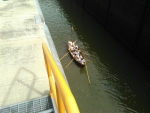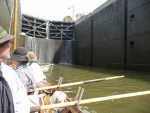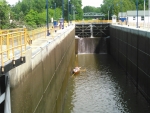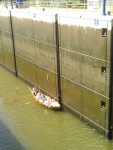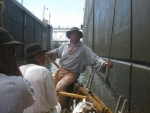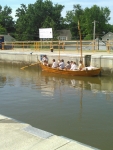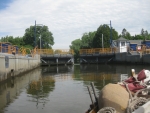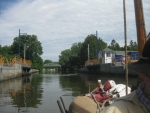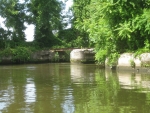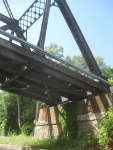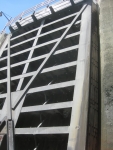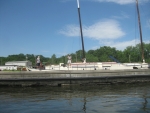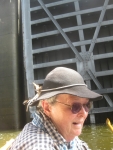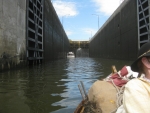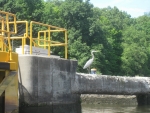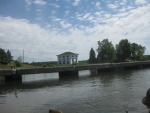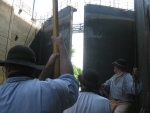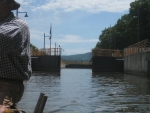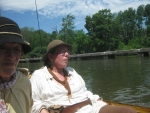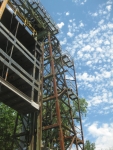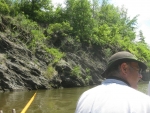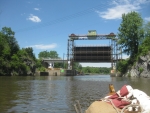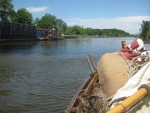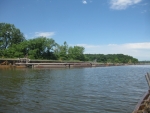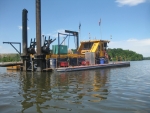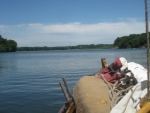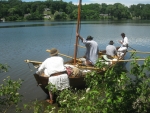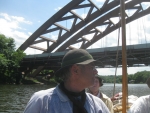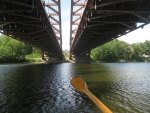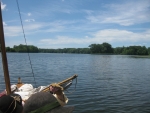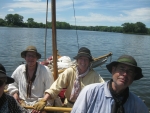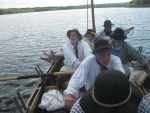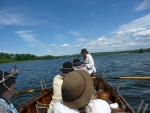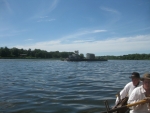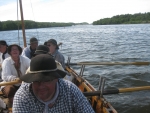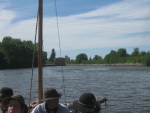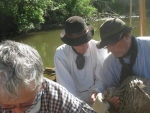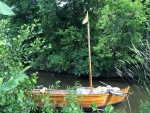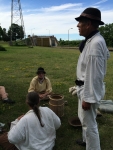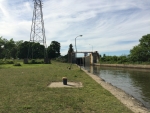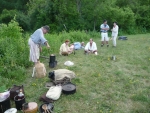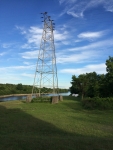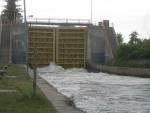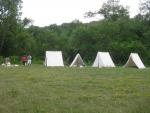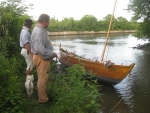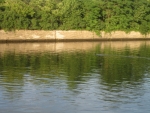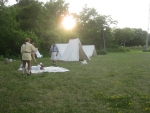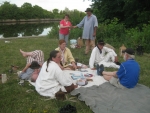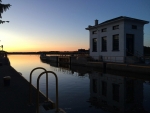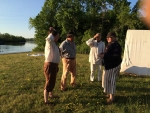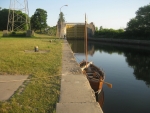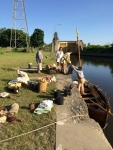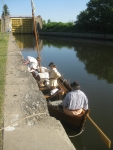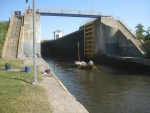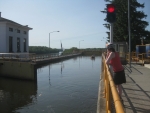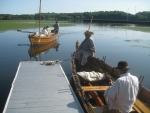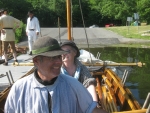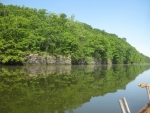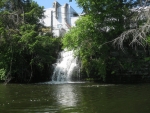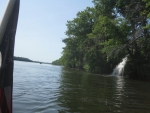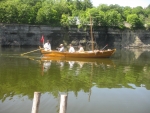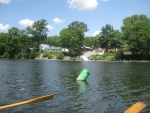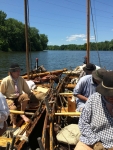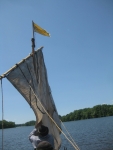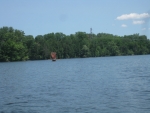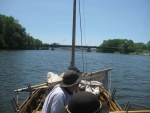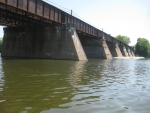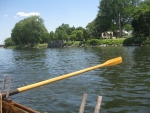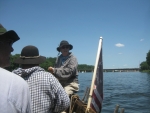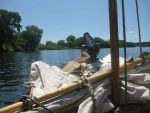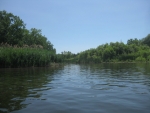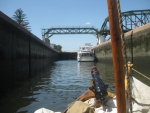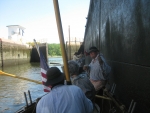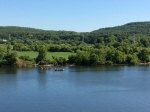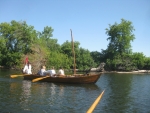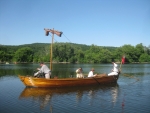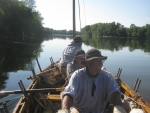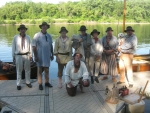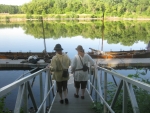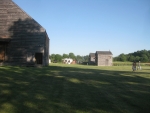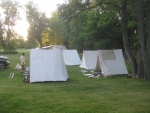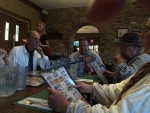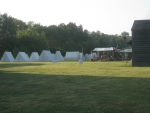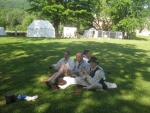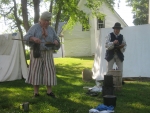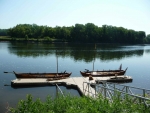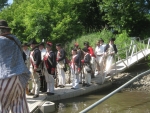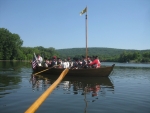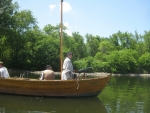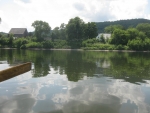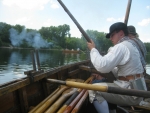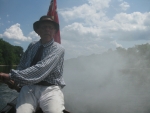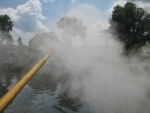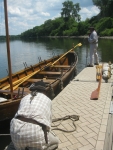Also known as ‘The Big Row, 2016’
Photos were taken by Peggy Huckel, Bill Manthey, Kevin Richard-Morrow, and Kim Mabee, and are copyright by the person who took them. Text is by myself, David Manthey.
Monday, 20 June 2016 – Rogers Island, New York
This Big Row is the reverse of the first trip we ever did. This year we are starting at Rogers Island in the Hudson River and ending at the Mabee Farm on the Mohawk River, arriving in time for their Revolutionary War reenactment. We are starting with one boat with the expectation that we will add a second boat either on Thursday or Friday as more crew also joins in. To start with, we have seven rowers, Reb, Bill, Judy, Kevin, Larry, Peggy, and myself.
Kevin, Peggy, and myself started the day at the Mabee Farm where we rowed the DeSager from our dock to the boat ramp. We then took the bateau out for use later in the week. This was a pleasant start to the day.
Kevin and I trailered the Bobbie G to Rogers Island in the afternoon. The northern end of the island is even shallower than last year, so launching was a chore, but we managed it. We had to row the boat over the shoals into the stiff current, then around the head of the gravel bars. We mostly drifted down the east side of the island to the Rogers Island Visitors Center’s dock.
All of our other rowers showed up, and we camped by the river with a good view of the boat. No disasters this year – the leaks are manageable, partly due to timely caulking and partly due to keeping a tub of “slick seam” on hand to fill problem areas with the waxy substance.
As always, it seems like we have an immense amount of gear and food to start with, especially as we have seven people in one boat. We’ve learned that we’d rather be somewhat crowded than completely exhausted or unable to proceed.
Trains passed by overhead. Locals came by and chatted with us. We ate dinner and had a leisurely evening. It was warm, and the cool metal ramp down to the dock was refreshing.
It doesn’t count for our official tally, but we rowed around 3 miles today.
Tuesday, 21 June 2016 – Stillwater Hudson Riverfront Park
We ate breakfast, struck camp, and loaded the boat. We got under way just after 7:40, which was a nice early start. Today is our longest planned day at 20 miles, though, as always, there are fallback options if there are issues.
We rowed down the east side of Rogers Island. As we passed the entrance to the Champlain Canal, we waved to a tug pushing a barge. The weather was clear and warm. A short while later the tug Frances passed us, too.
There was a wind consisting of occasional small flaws that made us hopeful for more. We put up the sail at times and could imagine that it did more good than harm. If nothing else, it gave breaks in the rowing while we hoisted and dowsed it. We probably got a mile of distance out of the wind, which was enough to enjoy the morning rum and cookies all the more.
We saw a number of osprey nests on top of telephone poles, including an osprey feeding its young.
After three or four miles, we entered a canal cut on the east side of the Hudson, entering under a guard gate. The canal cuts off a few miles of river that is bounded by a pair of dams, the lower of which is located by Fort Miller. We locked through Lock C-6 in good time and were once more in the river proper.
We stopped a while later for a natural break. The sky had a few small, high clouds, and the day was warm and pleasant.
We had our usual roving lunch, still making some distance while serving out our various food stuffs and eating. We watched a motorhome drive onto a narrow bridge as tractor trailers were crossing it in the opposite direction, causing the traffic to become backed up.
Upstream of the western canal cut for Lock C-5 there is a submerged dam. This always looks like it would be easy to wander out of the channel and go over, especially as there is usually a current that sweeps across the channel near a set of concrete blocks. This time the current didn’t seem very significant.
At Schuylerville we stopped at the town park for another necessary break. Here we encountered the mayor, who was very friendly. A delightful interlude.
The river below Schuylerville has some farms and trees. It passed by slowly and sunnily. We passed a dirt ramp that was one of our fall-back spots if we were to encounter trouble.
The afternoon slipped by, and sometime after 5 we arrived at the Stillwater Hudson Riverfront Park. This is a delightful town park with a grassy field, picnic tables, a nice pavilion, a hand-launch boat ramp, and a very small dock. We had obtained permission to camp overnight, and I had arranged to have a port-a-john on site for our use.
We tied up the Bobbie G, unloaded all of our gear, and set up camp. It was a lovely evening.
Judy made us a nice supper. A few friends stopped by to say hello. Kevin took his leave of us, as he has business that requires his personal attention tomorrow.
We turned in right around dark. 20 miles today.
Wednesday, 22 June 2016 – Waterford Visitors Center
Morning mists were rising off the Hudson River when we got up. We breakfasted and watched a few barges go by. The morning is the reverse of the evening: strike camp and load the boat. We got a good start, and were rowing down the river around 8 a.m.
Saratoga Battlefield is just up the hills to the west, and we discussed the local history as we rowed.
A few sprinkles of rain chilled us mid morning. Rum and cookies made it eminently more enjoyable. The only other boats we saw were a few hardy fishermen.
We tried to sail, but the wind just teased us. We continued to row.
The channel goes through Lock C-4 at Stillwater on the east side of the river. Below this is a tongue of land and an island which prevents any significant view of the town. We often speculate about visiting the blockhouse at the southern end of Stillwater, but it is never quite on the way.
The rain stopped by the time we passed under the railway bridge, but it was still cool and damp. The clouds gradually blew off, leaving mostly clear skies by the time we went through lock C-3 at Mechanicville. By Lock C-2, the weather was quite pleasant.
The wind was fluky, and we tried to sail between locks C-2 and C-1. This mostly involved hoisting the sail, getting one gust to push us forward, being immediately taken aback, and then deciding that it wasn’t cooperating and dousing the sail again.
Below Lock C-1 we tried to sail again. We hoisted sail and it started to draw tolerably well, even to the point that we put out the whiskerboom.
At this point a mishap occurred – we were dismasted, but in as undramatic a fashion as that could ever be.
Some background:
The masts for both of the bateaux are mostly identical. We made the pair of them a few winters ago. They are each 13 foot long pieces of what we think is Douglas fir taken from an old vinegar vat, rounded via spokeshave to roughly 2 1/2 inches in diameter. Each has a pennant staff affixed to the top with a pair of hand-forged brackets, extending the maximum height by another two feet. The mast has a dead eye for the halyard at the top, and the pennant staff has a smaller deadeye for the pennant line. The mast tops are carved with a decorative four-pointed star.
Two years ago, we attempted to see if we could tow a ship – the Half Moon. This is a roughly 150 ton vessel replica of Henry Hudson’s ship (with a variety of modern changes to meet various regulations). We had read about small boats towing ships and figured we should try it. While attempting to do so, we managed to crack our mast on the Half Moon’s bowsprit.
The mast was damaged, but not broken through. We repaired it by making a continuous seizing of tarred marline along the length of the fracture, extending a few inches on either side. The seizing was tight enough that it compressed the wood a small amount, and it in turn was fully secured by being coated in varnish. For a year and a half we had been using the mast with no apparent ill-effects or reduction in strength. Just in the last month or so, I had noticed that the mast appeared slightly bent, as if the fracture was no longer as securely fastened as before.
Back to the rowing trip:
We had hoisted the sail with a light wind from the starboard stern quarter. The wind was fluky, and we were taken aback almost immediately. I had asked Reb if we should douse the sail, and she had stood up to examine it, when a flaw of wind gusted from the larboard beam. It wasn’t strong, perhaps 8 miles an hour or so, but it was enough to flex the mast just so. With a gentle crack-crack-crack, the mast split completely at the bottom of the original fracture location and dropped to the starboard side, yard and lines all still attached.
Once we made sure everyone was fine, Reb, Judy, and others started to try to haul in the sail, broken mask, pennant, and all of the rigging. The seizing at the mast facture was now an impediment, so Reb cut it away (finally justifying always having a knife ready for rapid access). The mast and yard were hauled in, then the sail, then the various bits of rigging.
We weren’t far from Waterford, our evening destination, so after suitably sorting things out, we proceeded to row. We arrived in time to register at the harbor master’s office, get a key to the showers, and have a leisurely time unloading.
Waterford is a busy place in the summer. We talked with lots of different people. We spoke with the crew of a Swampscot dory that had rowed over from Troy. We shared stories with crews of other boats tied up at the town docks.
We set up camp, ate dinner, and showered. Kevin is to join us again tomorrow, and we contacted him and asked him to bring one of our spare masts when he comes. The spare masts are the boats’ originals, and are made from laminated pieces of oak which have warped severely and been trunnelled together to try to eke more use out of them. They aren’t great, but they are better than the broken mast.
About 17.5 miles today.
Thursday, 23 June 2016 – Lock E-7
A pleasant morning with a leisurely start. We had breakfast and broke camp. Ann showed up to join the crew. Kevin arrived with the DeSager and a spare mast. He couldn’t join today, as personal business continued to be pressing. Ultimately he took the DeSager away to rejoin tomorrow morning, leaving us with the best mast as a replacement. With seven rowers, we set out.
The first two miles are through the Flight of Five, locks E-2 through E-6. This is interesting, though slow. Each lock is around 35 feet in lift. The lock tenders seemed to run them somewhat slower than normal to give us a less turbulent ride than I’ve sometimes had.
Within the Flight there are decaying concrete structures that are picturesque. I suspect if one were moving large barges that they would have more purpose and their condition might matter more, too.
Past the guard gates at the top of the Flight, some Canal Corporation vessels were working on a dredging project. We waved to the workers as we went by.
Today there was a slight headwind, which made the going slower than we would have liked. It was never too much, but we were glad we still were all in one boat and not trying to move two bateaux with a distributed crew.
Now on the Mohawk River, our trip was measured by passing the Route 9 bridge and then the Thaddeus Kosciuszko bridges. We didn’t cause any cars to nearly swerve off the road this time.
Today was sunny. Rather than be pleased with the lack of rain, it mostly made us too hot. We took turns rowing and steering.
A barge carrying a large machine went by in the other direction pushed by the Lucy H out of Troy. It is nice to see a little commercial traffic on the canal system.
The day felt slow, and we felt tired. Familiar landmarks came and went, and eventually we arrived at the lower end of Lock E-7, our destination for the evening.
We pulled into the small creek at the bottom of the lock area on the south. The lock cycled a fair ways above us, and as it did, the water level in the creek first rose, then dropped nearly a foot, then eventually rose back to its original level. This proved a bit vexing, but eventually we figured out a safe way to moor the bateau so that it didn’t require constant attention. We kept an eye on it until the lock closed for the evening.
We unloaded the boat, and set up camp on the pleasant open field. Various people we knew stopped by. Despite not having joined us rowing during the day, Kevin joined us to make dinner, also bringing the DeSager so it could join the row tomorrow. Spouses of several different rowers checked in, including Peggy’s husband Jack bearing a birthday cake for her. Rick, one of our regular rowers, came with some liquid refreshments and another cake for Peggy. Monty, the boats’ dog also visited, along with Heather, who would later provide rides back to vehicles at the end of the row. Larry’s wife Kathy showed up to on us and to help celebrate Peggy’s birthday.
A fine evening. We chatted with the lock master, who remembered seeing us on the Champlain Canal on last year’s rowing trip. We watched a beaver who had taken up residence near the lock to raise her family.
We covered around 12.5 miles today, but it felt as much work as yesterday.
Friday, 24 June 2016 – Mabee Farm
A pleasant morning with a leisurely start. We had breakfast and broke camp. We moved the bateau to the lock wall, and loaded it down the wall rather than in the variable-depth creek.
A light crew rowed the Bobbie G up through Lock E-7. In the meantime, the rest of the crew readied the DeSager for launching. We rowed the Bobbie G to the dock at the boat launch, and adjusted the lading of the two boats. We mounted the swivel guns on the bateaux so we could fire a salute when we arrive at the end of the trip.
Now with eight rowers and two boats, we set off. The river passes pleasant short cliffs along the Knolls Atomic Power Lab and the General Electric research area. Along this area are some surprisingly attractive short waterfalls coming from cooling water outflows.
We had a dallied start, but now made decent time. There was a very slight head wind, but not so much as yesterday.
Rexford came and went. We passed the location where the boats were built. This was the Capital District Maritime Center, but it closed years ago. Now there are some rowing clubs that use the boat launch and maintain a low dock.
We rafted together for lunch, and ate as we kept a minimum way on.
The wind rose just slightly. We hoisted sails, but it didn’t give us any appreciable speed. The wind veered back and forth, and we struck sails after only a short time.
As we went through Schenectady, we could see a variety of new construction. We hope that they improve the looks of the area that is being turned into a casino, as it is currently just an ugly jumbled of rocks. Ann could spot her house as we went by the Stockade area.
On the south side is the Binnekill, historic construction location of Schenectady bateaux. It is now just a slightly wide inlet on the river. It once sported hundreds of boats and the bulk of the country’s westward trade.
We reached Lock E-8, our last lock of the trip. We locked through, then pulled up to the lock wall for a nature break.
Under way again, we soon went under the highway bridge, went passed the house of some friends, then went by the boat launch we usually use. We were now in the waters that we row in every week.
As we approached the Mabee Farm, we loaded the swivel guns. When we were close enough, each boat fired one salute to announce our arrival. Friends were waiting on the dock.
Today’s distance had been around 15 miles, for a whole trip of around 65 miles.
We gradually unloaded the boats. Heather took drivers back to Rogers Island and Lock E-7 to fetch cars and trailers. We set up camp by the trees and talked with our friends who were showing up for the reenactment weekend.
We all went to our usual haunt for a dinner we didn’t cook ourselves.
Saturday and Sunday, 25-26 June 2016 – Mabee Farm
We had plenty of eggs leftover from the trip, so we breakfasted on transported stores. We ate. We rested. We mended a few things. We enjoyed being at our home dock and not having to trailer the boat at the end of the event.
For the reenactment, we moved some troops and landed them. They were a fine set of soldiers and happy to be in the boats. We fired swivel guns and muskets. We set off smoke canisters. We rowed only relatively short distances.

